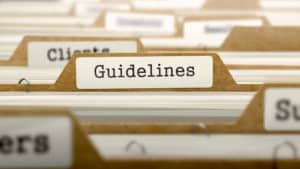A majority of states have some type of medical treatment guidelines in their workers’ compensation systems. They are generally intended to get the highest quality care to injured workers with an eye toward reigning in costs. Unnecessary treatments and medications can often be avoided when guidelines are followed.
But just as the workers’ compensation system is different in every jurisdiction, Medical Treatment Guidelines can vary widely from state to state. Organizations that operate in multiple locations may find it confusing to keep up with each jurisdiction’s guidelines; they may also get pushback from medical providers or others involved in the claims process. Understanding some of the challenges and following a few steps can help get the most benefits from guidelines.
Click Link to Access Free PDF Download
“8 ‘Think Outside the Box’ Tactics to Settle Workers’ Comp Claims”
What They Are
Medical Treatment Guidelines are written from a clinical perspective to help lend consistency and best practices in determining medical care for injured workers. They are a set of procedures, pre-appraised resources and tools intended to be the gold standard in medical treatment.
There are a variety of Medical Treatment Guidelines in workers’ compensation. The American College of Occupational and Environmental Medicine and the Official Disability Guidelines from the Work Loss Data Institute are the most prevalent, although many jurisdictions use just portions of each. Several states have developed their own, either based on either of the two national guidelines or developed in-house.
Some are intended to be educational tools for medical providers, while others are used as criteria to approve or deny treatment. Some are created via a strict scientific regimen. Others are approved by physicians on more of a consensual basis.
Proponents say properly written and followed guidelines can prevent inappropriate treatments and get injured workers back to function and work quicker. They point to the overprescribing of opioids as an example of a consequence for the failure to have guidelines. Better safety, clinical outcomes, shorter treatment, and improved return-to-work rates are among the benefits.
Challenges
While the Medical Treatment Guidelines may be the rule of the land in some jurisdictions, they are not cast in stone. That can be a positive factor, in that it allows for exceptions; however it can be a problem if medical providers either don’t understand the guidelines or refuse to adhere to them.
There are additional challenges posed by Medical Treatment Guidelines.
- Some are published online, while others are put manually into a system.
- Some jurisdictions struggle with keeping their guidelines current according to the latest medical research.
- Lack of info. Some of the more common occupational injuries have no associated Medical Treatment Guidelines.
- Everyone involved in a claim — the claims adjuster, nurse case manager, physician, UR and bill payment personnel must know and understand them for maximum effectiveness.
- Dispute resolution. Some states have a dispute resolution process focused on evidence-based medicine, while others do not.
- Decision makers. The treating physician has the final say in some jurisdictions, while payers can direct care in others.
- Approval/denial process. In some instances, the best treatment for a particular injured worker goes against the Medical Treatment Guidelines, but the provider fails to adequately explain the rationale.
Solutions
Understanding, consistency and common sense are key to getting the most out of Medical Treatment Guidelines. Here are steps to do that.
- Organizations need to understand the guidelines of each jurisdiction in which they operate. They need to pass on that information to their claims handlers, nurse case managers, physicians and all others involved.
- Coordinate. In addition to understanding the Medical Treatment Guidelines, those involved in the claims process must be consistent in their application.
- Work with doctors. Medical providers need to be on board with the guidelines for them to be effective. In cases where physicians may be leery of guidelines dictating the treatment, organizations should explain that exceptions are allowed.
- Where an injured worker has comorbidities, psychosocial issues or other extenuating circumstances, the guidelines may not offer the best hope for a positive outcome. Organizations must be willing to take a holistic approach to each injured worker and encourage those involved in the claims process to fully evaluate medical treatment requests that run counter to the guidelines.
- Overcoming denials. In situations where the best treatment does not concur with the guidelines, there should be a smooth process to review and decide on them quickly. For example, physicians working with the organization need to understand how to properly document exceptions to the guidelines and explain why recommended treatment can improve function.
- Communicate. Keeping stakeholders in the loop is critical. Any changes in guidelines must be passed on as soon as possible.
Summary
Medical Treatment Guidelines are not a panacea or ‘the silver bullet’ to quickly resolving claims. But where they exist, they are based on scientific evidence.
At the same time, treatment dictated by guidelines is not always right for each injured worker. Common sense and individual medical diagnosis of cases must also play a part in the decision making process.

Contact: mstack@reduceyourworkerscomp.com.
Workers’ Comp Roundup Blog: http://blog.reduceyourworkerscomp.com/
Injury Management Results (IMR) Software: https://imrsoftware.com/
©2024 Amaxx LLC. All rights reserved under International Copyright Law.
Do not use this information without independent verification. All state laws vary. You should consult with your insurance broker, attorney, or qualified professional.

















